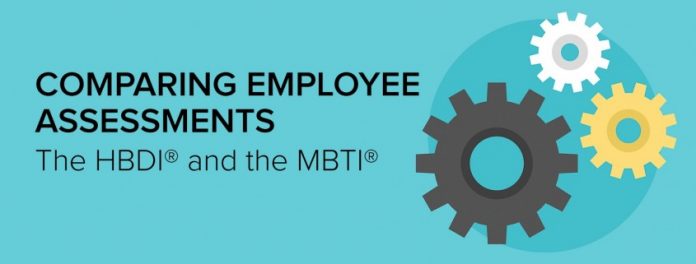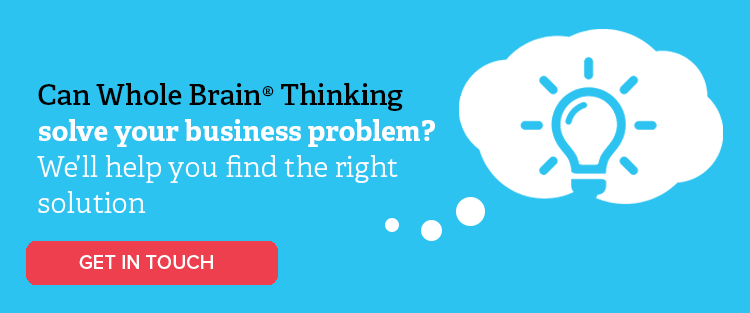In this ongoing blog series, we take a look at the similarities and differences of many employee assessment instruments and how you might use them – individually and together – to achieve your business and talent development needs. For this post, we discuss the Myers-Briggs Type Indicator® (MBTI®) and how it compares with Whole Brain® Thinking and the HBDI®.
As we take a look at another assessment, let’s start once again with the premise. The premise of the Myers-Briggs Type Indicator (MBTI) is a psychological assessment with a focus on personality, and it measures personality preference on four scales:
- Extraversion Introversion (E I),
- Sensing Intuition (S N),
- Thinking Feeling (T F),
- Judgment Perception (J P).
These personality preferences are then reported through the MBTI tool and result in 16 different personality types.
The MBTI assessment is used with individuals and teams to build self-awareness and help people comprehend differences. It’s often used to help leaders develop their skills and understanding themselves, their behavioural motivations and the impact their differences have on others. It’s also used in areas like career planning, conflict management and decision making.
Similarities and differences between the MBTI and the HBDI
While their premises are different (the HBDI is based on thinking preference), the HBDI and MBTI are complementary. Since thinking influences behaviour, there are connections between the two assessments, and you can see many correlations between the MBTI scales and the HBDI’s thinking preferences.
The Sensing/Intuition scale, for example, correlates with the B (green) quadrant and D (yellow) quadrants of the HBDI. In other words, each scale reflects a thinking preference that can be seen in the behaviours. For example, the practical, concrete and organised behaviours of the Sensing scale reflect B-quadrant thinking, and the imaginative, big picture and creative behaviours of the Intuitive scale reflect D-quadrant thinking.
Likewise, the Thinking/Feeling scale correlates with the A (blue) and C (red) quadrants of the HBDI. People with high A-quadrant preferences are often logical, critical and analytical, behaviours seen in the Thinking scale, while those with strong C-quadrant preferences often display behaviours that are expressive, interpersonal and empathetic, such as those in the Feeling scale.
Like the HBDI, the MBTI also measures degrees of preference, and your thinking and behavioural preferences can shift over time.
However, unlike the HBDI and Whole Brain® Thinking, the MBTI doesn’t have a methodology behind it to create a “common language” and support its ongoing application. This makes it more challenging for people to remember and apply it in daily practice. With its Whole Brain® Thinking methodology and many practical tools, the HBDI can easily be used as a diagnostic tool at every level of scale in an organisation, which is important when you’re trying to change culture, improve behaviour and develop capacity. During these transitions you want something that’s repeatable and can be applied in many different ways. While the MBTI can provide understanding and awareness around behavioural differences, it won’t help you with things like process mapping, innovation, strategy or change management.
And for the practitioner who’s facilitating, teaching and creating understanding, the MBTI is more complicated, both to master and deliver. It’s challenging for the learner to understand and retain as well.
People typically gain insight and see value in the experience, but because of the complexity of the model, the translation of that value into application is difficult. Even though there are some excellent booklets to help facilitate application, it can be a lot of work for the practitioner and the learner.
Another important point of difference between the two assessments is in how the premises are perceived. Because it’s a psychological assessment, the MBTI can get pushback from some learners who feel judged or vulnerable due to the focus on their personality and behaviour. The cognitive preferences measured by the HBDI don’t usually elicit that kind of reaction.
Using the assessments as complementary tools
While the two employee assessments measure different things, many companies choose to use both because thinking and behaviour are so connected.
In our work, we’ve found the two assessments to be a good complement to individual coaching efforts. For example, if coaching a leader over a period of time, it could be beneficial for them to take both the HBDI and the MBTI assessments. With the insights from both, they can identify the relationship between how they think, how they behave and how their thinking influences their behaviour. This can give them a clearer understanding of the specific practices to add for the greatest impact.
The beauty of these assessments is one informs the other, and people can easily see the similarities in how they think and how they behave. So, if you’ve already rolled out the MBTI, you can introduce the HBDI to explore what’s behind those behaviours – the person’s thinking preferences. Likewise, if you’re already using the HBDI and want to emphasise the behavioural/psychological aspects, you can add the MBTI. They work well together when that relationship between thinking and behaviour is clearly explained.
If you’d like to find out more about how HBDI can help you solve any business problem, get in touch with Herrmann.
This article was originally published in 2018. It has been updated in 2020 and republished to ensure our readers don’t miss out on valuable information.


